
 |
Tea Clipper |
 |
| from TeaAntiques.com | ||
| Edition Twenty Seven |
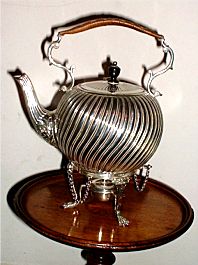 My
Featured Antique is a very pretty Victorian Silver plated 'Spirit' Tea Kettle
dating from around 1880. This is a very fine example of a Victorian Tea Kettle that
would have played an important part in the tea ceremony. The kettle itself sits
on a three legged stand which houses the spirit burner. The decoration of the globular
shaped kettle is charming, having a spirally shanked moulded body which is very
decorative. The kettle handle is beautifully scrolled and the top portion covered
in fashionable wicker.
My
Featured Antique is a very pretty Victorian Silver plated 'Spirit' Tea Kettle
dating from around 1880. This is a very fine example of a Victorian Tea Kettle that
would have played an important part in the tea ceremony. The kettle itself sits
on a three legged stand which houses the spirit burner. The decoration of the globular
shaped kettle is charming, having a spirally shanked moulded body which is very
decorative. The kettle handle is beautifully scrolled and the top portion covered
in fashionable wicker.
The stand has three legs to it, which terminate in cast lion paw feet. The Kettle has two locking pins to allow it to be carried with the stand and also to allow it to be tilted forward in order to refill the tea pot with fresh hot water. A delightful antique silver plated Spirit Kettle for the lover of tea antiques.
A little more history of tea kettles is given in an article within this edition of the Tea Clipper, which I hope you will find of some interest.
More details of this item and other tea related antiques can be found by visiting my web site at www.TeaAntiques.com.
Progressing with the story of Christmas decorations and traditions through the ages, we move from the late eighteenth century period where we ended in December's Tea Clipper and move now into the nineteenth century and the Regency period. Here we find ourselves in a small family room where a 'Twelfth-Night' party is about to take place. The celebration of Twelfth-Night has been celebrated at the end of the Christmas season since the Middle Ages. The celebration is part made up of the Christian feast of Epiphany, partly from the Wise Men arriving at the Stable where Christ was born and partly from the end of the twelve days around the pagan feast of Saturnalia, which centres around the winter solstice.
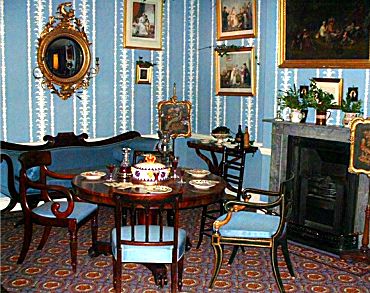
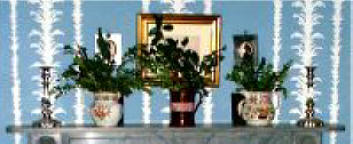
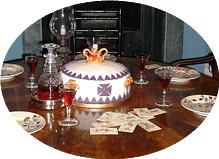 Dating
from medieval times, part of the custom has always incorporated elaborate disguises
and role reversals. A King and Queen are chosen for the night, who then lead the
celebrations, served by their 'courtiers'. So how was the King selected from the
party guests? Simple, a dried bean was baked in the traditional Twelfth Night cake,
he who has the bean becomes King. The Queen selected in a similar vein by the discovery
of a dried Pea within the cake. Sometimes, as this selection process was random,
one of the servants at the party could turn out to be the King for the evening,
to be served by his master all night.
Dating
from medieval times, part of the custom has always incorporated elaborate disguises
and role reversals. A King and Queen are chosen for the night, who then lead the
celebrations, served by their 'courtiers'. So how was the King selected from the
party guests? Simple, a dried bean was baked in the traditional Twelfth Night cake,
he who has the bean becomes King. The Queen selected in a similar vein by the discovery
of a dried Pea within the cake. Sometimes, as this selection process was random,
one of the servants at the party could turn out to be the King for the evening,
to be served by his master all night.
By the early nineteenth century such customs and traditions were being revived, as were the revival of the Christmas celebrations. The Twelfth-Night game was enjoyed by many and the cake became increasingly elaborate, with fine sugar frosting and gilded paper trimmings. It may also have been topped with figures made of plaster of Paris or sugar paste but the cake no longer contained the bean and pea of early times. The cake here is beautifully finished in the appearance of the King's crown
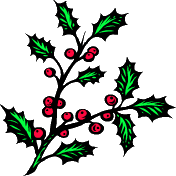
Following on from the Regency period, we are taken into the height of Christmas celebration in a Victorian home. This is the period that I think we all associate strongly with the sense of Christmas spirit and the story of Christmas past, a time when Dickens wrote his famous Christmas story 'A Christmas Carol'.
This room shows well the introduction of many of the customs we now associate with Christmas; it is dominated by a large real Christmas tree, which has been beautifully decorated by members of the family. These decorations, some of which may have been hand made by the children, include small candles, toy musical instruments, animals, flags and little baskets of sweets. Below the tree sit the presents belonging to the family, the children waiting impatiently for the time when they may be unwrapped.
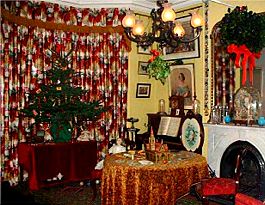 It
was in the Victorian period that many of our customs and traditions became widespread,
including the incorporation of a fir tree in the home, covered in decorations. It
is often thought that Prince Albert, husband of Queen Victoria, first introduced
the Christmas tree into England from Germany. However, this tradition probably pre-dates
this, as Queen Charlotte, the German wife of King George III may have introduced
it for her family during the 1780s and 1790s. However, it was certainly the enthusiasm
for Christmas of Prince Albert that popularised the use of the Christmas tree in
the home outside of Court circles.
It
was in the Victorian period that many of our customs and traditions became widespread,
including the incorporation of a fir tree in the home, covered in decorations. It
is often thought that Prince Albert, husband of Queen Victoria, first introduced
the Christmas tree into England from Germany. However, this tradition probably pre-dates
this, as Queen Charlotte, the German wife of King George III may have introduced
it for her family during the 1780s and 1790s. However, it was certainly the enthusiasm
for Christmas of Prince Albert that popularised the use of the Christmas tree in
the home outside of Court circles.
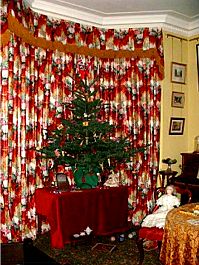 Queen
Victoria would have a very large Christmas tree at Windsor Castle every Christmas,
but it was in 1848, when a picture was published of the royal children stood beside
the Christmas tree that it sparked off the craze for everybody to have a tree at
Christmas - and so the tradition continues.
Queen
Victoria would have a very large Christmas tree at Windsor Castle every Christmas,
but it was in 1848, when a picture was published of the royal children stood beside
the Christmas tree that it sparked off the craze for everybody to have a tree at
Christmas - and so the tradition continues.
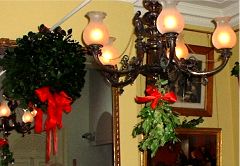 In
this room, we can see the decorations now include much more greenery, a wreath of
holly and ivy hangs above the mantle mirror and a bunch from the central chandelier.
In
this room, we can see the decorations now include much more greenery, a wreath of
holly and ivy hangs above the mantle mirror and a bunch from the central chandelier.
The room depicts the drawing room of a young family sometime around mid-afternoon on Christmas Eve. The young mother makes preparations for the celebrations tomorrow. She may have spent the morning shopping for presents and instructing cook on the dinner to be served tomorrow. She will have been encountering the crowds around Oxford Street's shops and travelling home by the underground railway. Later she will be filling stockings with gifts for the children, to be hung from the mantle piece ready for the children to discover in the morning. The tradition of Christmas stockings was a new tradition in England, adapted from a tradition in America where shoes are left out on St Nicholas's Day. This shoe custom was taken to America by the settlers from Holland.

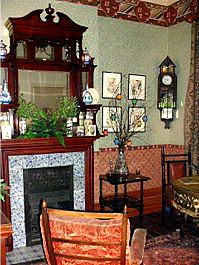
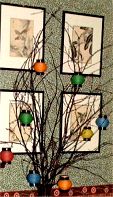 Leaving
the Victorians behind to enjoy their Christmas celebrations, we move through time
to the early nineteenth century and the Aesthetic Movement, with its love of anything
Japanese. Here the room can be seen to be decorated with simple decorations such
as the vase of bare twigs, from which hang Japanese style lanterns. Japanese paper
fans may also have been used to decorate such rooms of this period.
Leaving
the Victorians behind to enjoy their Christmas celebrations, we move through time
to the early nineteenth century and the Aesthetic Movement, with its love of anything
Japanese. Here the room can be seen to be decorated with simple decorations such
as the vase of bare twigs, from which hang Japanese style lanterns. Japanese paper
fans may also have been used to decorate such rooms of this period.
We now start to see the wide-spread use of Christmas greeting cards. The Christmas card is an English invention, devised by Sir Henry Cole in 1843. It was introduced to save Mr Cole time; as he had numerous business and social contacts and so individually written greetings would have taken him a long time. Hand written greetings had been practiced before, even by eighteenth century children sending greetings to their parents - but these were not yet in the form of Christmas cards.
It was not until the 1860s that the tradition of sending Christmas cards really took off, and even more so with the introduction of cheaper rate postage for postcards and unsealed envelopes in the 1870s.

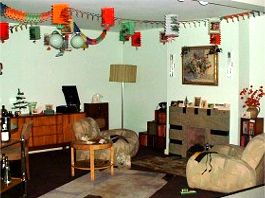
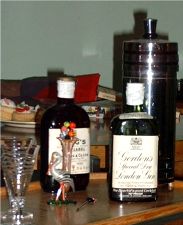 Moving
on to an era that I can just remember as a child, the late 1950s, we can see a typical
middle class living room. The ceiling hung with paper chains and paper lanterns,
the table set for an evening celebration, the gin at the ready for when the children
have gone off to bed!
Moving
on to an era that I can just remember as a child, the late 1950s, we can see a typical
middle class living room. The ceiling hung with paper chains and paper lanterns,
the table set for an evening celebration, the gin at the ready for when the children
have gone off to bed!

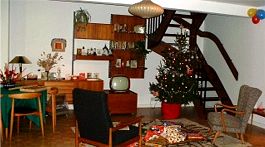
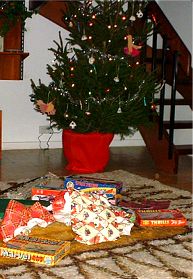 Swiftly
moving towards our present time, we pass through the 1970s. Here the room depicts
a family's living room at a time just after the Christmas presents have been hastily
unwrapped by the children. There is a a mess of discarded wrapping paper on the
floor. There are presents for the children of games, toys and books. One can imagine
the children running about and playing with their toys, stuffing themselves with
sweets before lunch is served.
Swiftly
moving towards our present time, we pass through the 1970s. Here the room depicts
a family's living room at a time just after the Christmas presents have been hastily
unwrapped by the children. There is a a mess of discarded wrapping paper on the
floor. There are presents for the children of games, toys and books. One can imagine
the children running about and playing with their toys, stuffing themselves with
sweets before lunch is served.
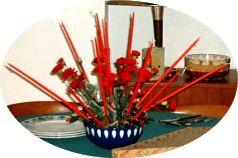 Lunch
will be the now traditional turkey, potatoes, sprouts and all the necessary accompaniments.
Mother has been a little adventurous with the Christmas table decoration this year
with red Carnations and long thin candles-so very modern, I hope that she does not
end up with wax over the table!
Lunch
will be the now traditional turkey, potatoes, sprouts and all the necessary accompaniments.
Mother has been a little adventurous with the Christmas table decoration this year
with red Carnations and long thin candles-so very modern, I hope that she does not
end up with wax over the table!

Finally our long journey from Christmas past ends with a modern flat in one of the new London developments in the East End. A flat owned by a young professional couple with no time for children at the moment. It shows us their Christmas afternoon when they have invited over a few friends for the afternoon for Christmas lunch. Everybody is drinking Champagne whilst exchanging small Christmas presents. The table is surrounded by colourful plastic chairs and the table laid with similarly colourful Christmas crackers. The hosts may well be a little nervous of cooking a lunch, after all, they normally eat out, and do not cook in their own kitchen!
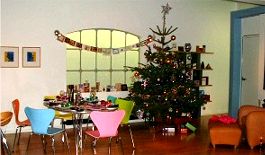
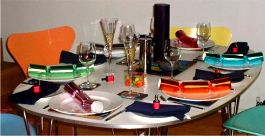
The Christmas tree is decorated with expensive trifles that they have bought in shops like 'Heal's and other small designer shops. Their evening will be spent relaxing together in front of the television, maybe watching a film or listening to some of their CDs.
Most of the information about each period was taken form the display boards in the Museum itself - such a wealth of interesting information.
Things have come a long way, and our traditions of Christmas adapt, change and move on. What ever you do to celebrate your Christmas and what ever period in which you feel most at home, may I wish you a VERY MERRY CHRISTMAS and a HAPPY NEW YEAR.

Admission to the museum is free and it is open on most days of the year, except Mondays (unless a Bank Holiday), Good Friday, Christmas Eve, Christmas Day, Boxing Day and New Year's Day. For full details you can contact the museum on 020 7739 9893, or visit their Web address : www.geffrye-museum.org.uk
Click here for
Local Map
Click here for
Area Map
Maps courtesy of www.streetmap.co.uk
With the thought of ‘Christmas Spirit’, I thought it appropriate to do an article on ‘sprit kettles’ – Spirits from the past! This essential item of tea equipage from the past appears not to be a familiar item with some people. Indeed, I have had many queries from my customers or Tea Clipper readers as to the purpose these Spirit Kettles. I will endeavour to explain a little about them.
The purpose of the spirit kettle, usually known as a tea kettle, was essentially to provide a source of constantly hot water for use in the tea taking ceremony. It was necessary to have a supply of hot water for the host, or hostess, to top the teapot up as required.
In England, tea kettles date back to the end of the seventeenth century, although in this very early period they were known by different names. There are accounts and documents that refer to them as ‘Tea Kettles with a lamp’; ‘kettles with lamps and stands’ or ‘furnaces’. We now generally refer to them as just ‘tea kettles’.
Tea in the early period tea was drunk only by the very wealthy, it being extremely expensive to buy. It was drunk at home and the servant would bring all the necessary tea making equipage into the room in which tea was to be served. The host or hostess would probably make the tea and perform the ceremony of pouring tea for their guests. In order for this to happen, a supply of boiling water was required which the servant would provide from a boiling hot kettle from the kitchens. This boiling water was poured by the servant into the tea kettle. The tea kettle, has beneath it a container or ‘burner’ that is filled with an inflammable spirit. A wick comes from the spirit burner, the wick was lit and the flame would keep the water hot. The tea kettle was designed to keep the boiling water hot, never to actually boil the water from cold.
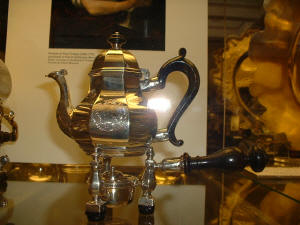
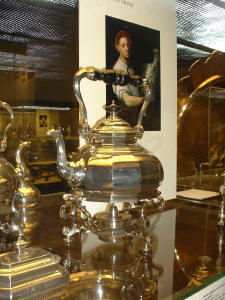
The very early tea kettles followed the shape of the early teapots, many in the early part of the eighteenth century were hexagonal or octagonal in shape rather like a ‘squat’ pear. These usually had hinged swing handles, having a wooden section in the middle to allow them to be picked up without burning the hand. The kettle would sit on a three- or four-legged silver stand or frame, from which it was detachable. The spirit burner sat in the centre of the frame under the kettle to provide the heat.
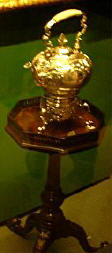
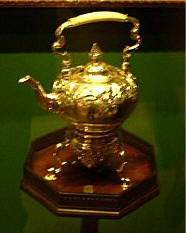 Initially,
tea kettles, like teapots, were of a small size. However, as the eighteenth century
progressed and the price of tea fell, the size of the tea kettle, like that of the
teapot, increased. By the middle of the eighteenth century when rococo design was
fashionable, there were some beautiful and very decorative tea kettles produced.
The frames on which the kettle sat sometimes had elaborate cast legs and feet with
shell motifs. Also, decorative cast open work aprons were included below the top
of the stand frame, thus shielding the flame of the burner and allowing the silversmith
to exude his skills in producing naturalistic decoration.
Initially,
tea kettles, like teapots, were of a small size. However, as the eighteenth century
progressed and the price of tea fell, the size of the tea kettle, like that of the
teapot, increased. By the middle of the eighteenth century when rococo design was
fashionable, there were some beautiful and very decorative tea kettles produced.
The frames on which the kettle sat sometimes had elaborate cast legs and feet with
shell motifs. Also, decorative cast open work aprons were included below the top
of the stand frame, thus shielding the flame of the burner and allowing the silversmith
to exude his skills in producing naturalistic decoration.
Often, the kettle was hinged at the front of the frame, and with a locking pin at the back. This arrangement meant that with the locking pin in place the whole assembly of kettle, stand and burner could be carried by the kettle's handle. In order to fill a teapot with water, the back locking pin was removed, thus allowing the kettle to be tilted forward pouring the hot water into the teapot.
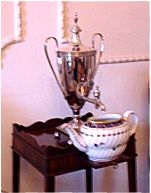 By
the 1760s, tea kettles were becoming rather large and unwieldy, ladies of the house
finding it difficult to use them in their tea ceremony. Thus it was in this period
the tea urn was introduced. These, having a pouring spout with a tap allowed the
teapot to be filled by simply placing it below the urn's spout and opening the tap
– no heavy lifting of the tea kettle! However, the tea kettle did not die out and
indeed remained still popular into the twentieth century – often copying earlier
styles.
By
the 1760s, tea kettles were becoming rather large and unwieldy, ladies of the house
finding it difficult to use them in their tea ceremony. Thus it was in this period
the tea urn was introduced. These, having a pouring spout with a tap allowed the
teapot to be filled by simply placing it below the urn's spout and opening the tap
– no heavy lifting of the tea kettle! However, the tea kettle did not die out and
indeed remained still popular into the twentieth century – often copying earlier
styles.
Today, such pretty tea kettles can look very decorative and impressive sat on a tea table or stood on a sideboard. I still use one today, not just as decoration, but to keep my boiling water hot during formal afternoon tea in the drawing room - what pleasure it gives me in seeing and using it. No doubt it will be assisting me over the Christmas and New Year period, sat round the log fire with a plate of hot mince pies for my guests. I hope that you get a chance to sit and enjoy an afternoon tea over Christmas too.
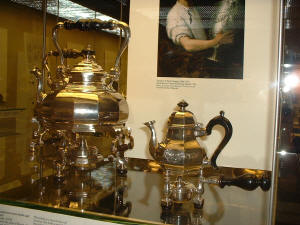
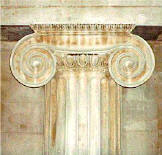
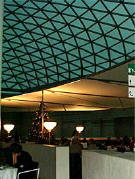 Should
you find yourself in London during the Christmas and New Year season, then why not
take a little time away from the rush around the shops to take tea at the British
Museum. Apart from the display galleries that house many treasures from around the
world there is a pleasant central restaurant in which to enjoy a relaxing afternoon
tea. I took just such an opportunity when I was in London doing a little Christmas
shopping.
Should
you find yourself in London during the Christmas and New Year season, then why not
take a little time away from the rush around the shops to take tea at the British
Museum. Apart from the display galleries that house many treasures from around the
world there is a pleasant central restaurant in which to enjoy a relaxing afternoon
tea. I took just such an opportunity when I was in London doing a little Christmas
shopping.
I found the Court restaurant a very light venue, perched at the top floor of the additional extension cleverly built around the historic centre circular Reading Library. From the restaurant, if sat at a table on the inside against the Library wall, it is possible to sit and enjoy tea gazing down into the Library below thought its large high windows.
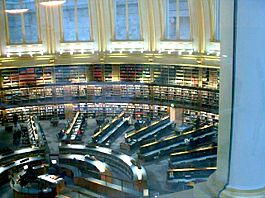
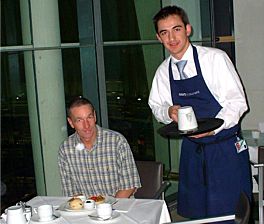
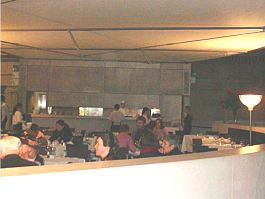
The atmosphere feels very modern, especially with the stark white stone surroundings and the immense glass domed covered roof of the courtyard of the Museum.
Tea was a pleasing experience, served by friendly waiters and waitresses, neatly turned out in blue aprons. There are a number of fixed traditional afternoon teas from which to choose, ranging from just the straight forward tea with scones, Dorset jam and clotted cream together with a slice of cake, to a Great Court Tea comprising a glass of Champagne, smoked salmon sandwiches, cream cheese and cucumber sandwiches, fruit scone, Dorset jam, Cornish clotted cream, and a slice of cake.
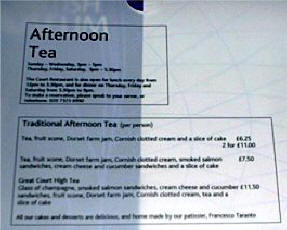
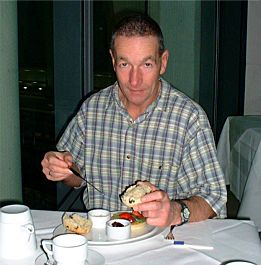
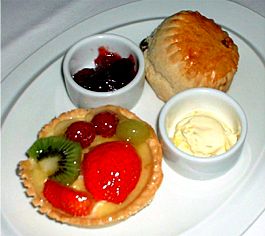
On this occasion, I opted to have tea with a fruit scone and choice of cake, for which I choose a fresh fruit tart. I was not disappointed and after a hard morning shopping it came as a welcome break which I enjoyed. I recommend it if you are in that area of London.
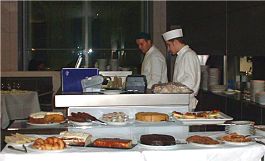 The British Museum
The British Museum
Great Russell Street
London WC1B 3DG
Tel: 020 7323 8000 (switchboard)
Tel: 020 7323 8299 (information desk)
Website: www.thebritishmuseum.ac.uk
Click here for
Local Map
Map courtesy of www.streetmap.co.uk
May I wish all my customers and Tea Clipper readers a very Happy New Year for 2003
To review past newsletters, just follow this link:
Past newsletters.
To subscribe to this free newsletter -
Click here